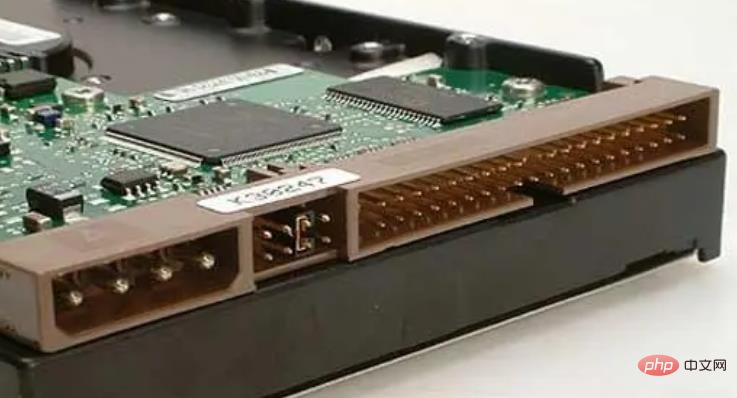what is ide
IDE is "electronic integrated drive", its full English name is "Integrated Drive Electronics", that is, "electronic integrated drive", or "integrated device circuit"; its original meaning is "hard disk controller" A hard drive integrated with the "disk body"; IDE is a type of disk drive interface. The hard disk and optical drive are connected to the motherboard through the IDE interface; the controller circuit resides in the drive, and a separate adapter card is no longer needed.

The operating environment of this tutorial: Windows 10 system, DELL G3 computer
What is ide?
IDE, the full English name is "Integrated Drive Electronics", that is, "electronic integrated drive", or "integrated device circuit". Its original meaning refers to the hard drive that integrates the "hard disk controller" and the "disk body".

Its original meaning refers to the hard drive that integrates the "hard disk controller" and the "disk body". IDE is a type of disk drive interface. The hard disk and optical drive are connected to the motherboard through the IDE interface. The controller circuitry resides within the drive, eliminating the need for a separate adapter card.
The basic idea behind the IDE is that the hard drive and controller should be combined together. Controllers are small circuit boards that contain chips that control how the hard drive properly stores and accesses data. Most controllers also come with some memory, which acts as a buffer to enhance hard drive performance.
For users, hard disk installation is also more convenient. The interface technology of IDE has been continuously developing since its birth, and its performance has been continuously improved. Its low price and strong compatibility have made it irreplaceable by other types of hard drives.
IDE represents a type of hard disk, but in actual applications, people are also accustomed to using IDE to refer to the earliest IDE type hard disk ATA-1. This type of interface has been developed with the development of interface technology. was eliminated, and later developed more types of hard disk interfaces, such as ATA, UltraATA, DMA, UltraDMA and other interfaces are all IDE hard disks.
PIDE hard disk
PIDE hard disk has the following three transmission modes: PIO (Programmed I/O) mode, DMA (DirectMemoryAccess) mode, UltraDMA (referred to as UDMA) mode .
The biggest drawback of the PIO (Programmed I/O) mode is that it consumes a huge amount of CPU resources. The IDE interface running in PIO mode has a data transfer rate of 3.3MB/s (PIOmode0) ~ 16.6MB/s (PIOmode4).
PDMA (DirectMemoryAccess) mode is divided into two types: Single-WordDMA and Multi-WordDMA. The maximum transfer rate of Single-WordDMA mode is 8.33MB/s, and Multi-WordDMA (DoubleWord) can reach 16.66MB/s.
The biggest difference between PDMA mode and PIO mode is that DMA mode does not rely too much on CPU instructions to operate, which can achieve the effect of saving processor running resources. However, due to the emergence and rapid popularity of UltraDMA mode, these two modes were immediately replaced by UDMA.
PUltraDM mode (UDMA for short) is a standard cited in the UltraATA format, using the 16-bitMulti-WordDMA mode as the benchmark. One of the advantages of UDMA is that in addition to the advantages of DMA mode, it also applies CRC (Cyclic Redundancy Check) technology to enhance the performance of error detection and debugging during data transmission.
Since the implementation of the PUltraATA standard, its interface has applied DDR (Double DataRate) technology to double the transmission speed. The transmission speed of UltraATA/100 is as high as 100MB/s.
For more related knowledge, please visit the FAQ column!
The above is the detailed content of what is ide. For more information, please follow other related articles on the PHP Chinese website!

Hot AI Tools

Undresser.AI Undress
AI-powered app for creating realistic nude photos

AI Clothes Remover
Online AI tool for removing clothes from photos.

Undress AI Tool
Undress images for free

Clothoff.io
AI clothes remover

AI Hentai Generator
Generate AI Hentai for free.

Hot Article

Hot Tools

Notepad++7.3.1
Easy-to-use and free code editor

SublimeText3 Chinese version
Chinese version, very easy to use

Zend Studio 13.0.1
Powerful PHP integrated development environment

Dreamweaver CS6
Visual web development tools

SublimeText3 Mac version
God-level code editing software (SublimeText3)

Hot Topics
 1378
1378
 52
52
 How to install IDLE Python IDE under Ubuntu and other Linux
Apr 08, 2023 pm 10:21 PM
How to install IDLE Python IDE under Ubuntu and other Linux
Apr 08, 2023 pm 10:21 PM
IDLE (Integrated Development and Learning Environment) is a Python IDE written in the Python language itself and is usually installed as part of the Python installation on Windows. It's ideal for beginners and is simple to use. For those who are learning Python, such as students, it serves as a great IDE to get started. Basic features like syntax highlighting, smart recognition, and auto-completion are some of the features of this IDE. You can always read it in the official documentation
 Recommended five best free C++ compilers for Windows 11
Apr 23, 2023 am 08:52 AM
Recommended five best free C++ compilers for Windows 11
Apr 23, 2023 am 08:52 AM
C++ is a widely used object-oriented computer programming language that powers most applications and websites you interact with. You need a compiler and an integrated development environment to develop C++ applications, and since you are here, I'm guessing you are looking for one. We’ll cover some of our top recommendations for C++ compilers for Windows 11 in this article. Many of the compilers reviewed will be primarily for C++, but there are also many general-purpose compilers you might want to try. Can MinGW run on Windows 11? In this article we have not discussed MinGW as a standalone compiler, but if the functionality in some IDEs is discussed and is the preferred compiler for DevC++
 What does IDE mean?
Mar 18, 2021 pm 03:37 PM
What does IDE mean?
Mar 18, 2021 pm 03:37 PM
The full name of ide is "Integrated Development Environment", which means "integrated development environment" in Chinese. It is an application used to provide a program development environment. It is an integrated development software service that integrates code writing functions, analysis functions, compilation functions, debugging functions, etc. set.
 Ten Python IDEs and code editors highly recommended!
Apr 19, 2023 pm 07:04 PM
Ten Python IDEs and code editors highly recommended!
Apr 19, 2023 pm 07:04 PM
Python is a very easy to learn, powerful programming language. Python includes efficient high-level data structures, providing simple and efficient object-oriented programming. The learning process of Python is indispensable without an IDE or code editor, or an integrated development editor (IDE). These Python development tools help developers speed up development using Python and improve efficiency. An efficient code editor or IDE should provide plug-ins, tools and other features that can help developers develop efficiently. 1.VimVim can be said to be the best IDE for Python. Vim is an advanced text editor designed to provide the actual Unix editor 'Vi' functionality and support more and more complete features.
 What are the Chinese IDEs for developing PHP?
Aug 17, 2023 pm 01:23 PM
What are the Chinese IDEs for developing PHP?
Aug 17, 2023 pm 01:23 PM
Chinese IDEs for developing PHP include PHPStorm, Zend Studio, Sublime Text, Visual Studio Code, NetBeans, etc. Detailed introduction: 1. PHPStorm, which provides a powerful code editor, code auto-completion, debugging tools and version control system integration; 2. Zend Studio, which supports many popular PHP frameworks and provides rich code navigation and refactoring functions. ;3. Sublime Text, etc.
 Essential for professional Go developers: five top software recommendations
Mar 15, 2024 am 11:48 AM
Essential for professional Go developers: five top software recommendations
Mar 15, 2024 am 11:48 AM
As a professional Go developer, choosing the right software tools is crucial. In daily development, having efficient, stable and powerful software can greatly improve our work efficiency. Below we will recommend five top software for you. Each software is accompanied by specific code examples. I hope it will be helpful to you. 1.VisualStudioCodeVisualStudioCode (VSCode for short) is a lightweight modern code editor launched by Microsoft that supports G
 what is ide
Jan 31, 2023 am 11:23 AM
what is ide
Jan 31, 2023 am 11:23 AM
ide is "electronic integrated drive", and its full English name is "Integrated Drive Electronics", that is, "electronic integrated drive", or "integrated device circuit"; its original meaning is to integrate the "hard disk controller" with the "disk body" Hard drives together; IDE is a type of disk drive interface. The hard disk and optical drive are connected to the motherboard through the IDE interface; the controller circuit resides in the drive, eliminating the need for a separate adapter card.
 Detailed graphic explanation of how goland ide resolves conflicts
Oct 28, 2022 pm 05:14 PM
Detailed graphic explanation of how goland ide resolves conflicts
Oct 28, 2022 pm 05:14 PM
This article is introduced by the golang tutorial column to you on how to resolve conflicts in goland ide. I hope it will be helpful to friends in need!



